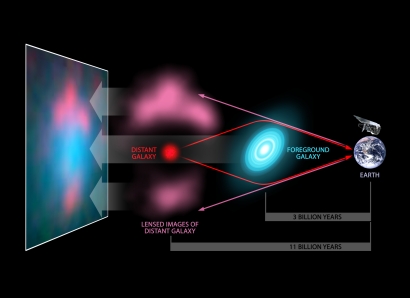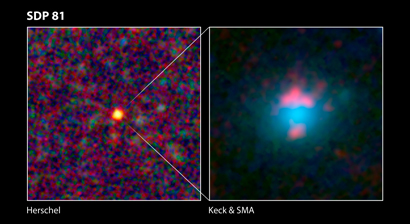New method reveals gravitationally lensed galaxies in Herschel-ATLAS first survey
4 November 2010
Astronomers using early data from one of the largest projects to be undertaken withthe ESA Herschel Space Observatory have demonstrated that virtually all bright sub-millimetre galaxies in the distant Universe are subject to gravitational lensing, whichamplifies their flux thus easing their detection and characterisation. Analysis of lessthan three per cent of the entire Herschel-ATLAS survey, which probes the distantand hidden Universe, yielded a first sample of five lensed galaxies and paves the wayfor the compilation, in the near future, of a rich catalogue of distant, star-formingand dust-obscured galaxies. The results are reported in the 5 November 2010 issueof Science.
|
Gravitational lenses in part of the Herschel-ATLAS survey field. |
Particularly useful in this context, as they contain some all-important information about the early stages of galaxy formation, is a class of distant galaxies characterised by intense dust-enshrouded star formation. On the one hand, the dust makes them hard to detect with optical telescopes because it absorbs starlight; on the other hand, it is this very same dust, heated by the intense star formation, that shines brightly at wavelengths of a few hundred microns - thus they are referred to as sub-millimetre galaxies (SMGs). Thus far only observed with ground- based and balloon-borne radio telescopes, SMGs are an ideal target for Herschel, which is sensitive to emission spanning the wavelength range 55 to 671 microns.
With very high redshifts, sometimes exceeding z~3, distant SMGs are extremely hard to identify: even in the best cases, they can be detected only as faint smudges and studying their characteristics in detail is observationally demanding and time-consuming. Fortunately, nature sometimes comes to the aid of astronomers by providing them with cosmic magnifying glasses, spread here and there across the cosmos. As demonstrated by Einstein's theory of general relativity, massive objects like galaxies and galaxy clusters deflect the light coming from background sources — a phenomenon known as gravitational lensing. In the 5 November 2010 issue of the journal Science, a team of astronomers, led by Mattia Negrello from the Open University in the UK, report on the successful demonstration of a method that exploits the gravitational lensing effect to study both the distant SMGs and the foreground galaxies that act as lenses on them.
A multitude of galaxies populate the intervening space between distant SMGs and an observer and, when an SMG is aligned with one of these foreground galaxies, interesting effects arise. "Just like with an ordinary glass lens, the background source is magnified and its shape is distorted in a way that depends on the intervening galaxy and on the relative distances of the galaxies," explains Negrello. "As a result, the flux of an SMG that experiences gravitational lensing is amplified with respect to that of its unlensed counterparts, enabling us to detect it more easily and to determine its properties with much greater accuracy," he adds.
|
Illustration of gravitational lensing. Credit: NASA/JPL-Caltech |
The method presented in this study relies on a previous finding which demonstrated that, under certain assumptions regarding the formation of galaxies, SMGs are not expected to be brighter than 100 milliJansky at a wavelength of 500 microns unless they are magnified by a gravitational lens. "We realised that selecting all the sources with a flux higher than this threshold, among those detected in the 500-micron channel of the SPIRE instrumenton board Herschel, is an extremely efficient criterion to discover gravitationally lensed SMGs," says Negrello. A good fraction of the sources detected in this way are predicted to be 'contaminants' – other galaxy-types that are not interesting in this context – but these are rather straightforward to identify through comparison with auxiliary data, leaving astronomers with a catalogue of lensed SMGs that would have remained completely unnoticed through other selection criteria.
"These considerations suggested that a search for gravitationally lensed SMGs would make a great science case for the Herschel Astrophysical Terahertz Large Area Survey (H-ATLAS), an ambitious project aimed at compiling the largest-area survey currently undertaken by the observatory," notes Steve Eales from Cardiff University in the UK, co-leader of H-ATLAS. When completed, H-ATLAS will cover about 550 square degrees of the sky at wavelengths from 100 to 500 microns, using both the PACS and SPIRE instruments aboard Herschel, providing an extended dataset to study both local and distant galaxies, as well as stellar systems in our own Galaxy. H-ATLAS is one of the 42 Key Programmes that have been awarded observing time on Herschel to be carried out in the early phases of the mission.
"One of the main goals of Herschel is to deepen our understanding of how cosmic structure formed and evolved, on every scale and over cosmic time, to give rise to the Universe we observe today. Unravelling galaxy formation and evolution from a cosmological perspective is a crucial piece of the puzzle and the subject of as many as five Key Programmes, including H- ATLAS," comments Göran Pilbratt, Herschel Project Scientist.
The quest for gravitationally lensed galaxies is one of the scientific drivers of H-ATLAS and the current result shows that the proposed method, now tested on the first 14.4 square degrees of the survey observed during the Science Demonstration Phase, works extremely well. From these data, amounting to only three per cent of the entire survey, the criterion revealed 11 sources with a flux above the chosen threshold. Six of them are contaminants, whereas the remaining five, identified as lensed SMG candidates, have been later confirmed as such by a series of dedicated follow-up observations.
|
A gravitational lens discovered by Herschel. |
After contamination removal, this method delivers a sample of gravitationally lensed SMGs with an efficiency of almost 100 per cent. "We have finally opened a new window on these previously poorly known objects, which are crucial for our understanding of how galaxies formed and evolved in the Universe," comments Loretta Dunne, co-leader of H-ATLAS, from the University of Nottingham in the UK. The current sample, comprising only a handful of sources, anticipates the outcome of future applications of the method to the entire H-ATLAS field, which are expected to detect over 100 lensed SMGs. This rich database will significantly improve the constraints on models for the formation and evolution of galaxies. "The present result, achieved using the early H-ATLAS data, gives us a taste of the ground-breaking science that can be carried out once the survey is complete," concludes Pilbratt.
Notes for editors:
The Herschel ATLAS (Astrophysical Terahertz Large Area Survey) is the largest Herschel open- time key project. It was awarded 600 hours of Herschel observation time to survey 550 square degrees of sky in 5 bands (100 μm, 160 μm, 250 μm, 350 μm, & 500 μm). It is expected to detect approximately
Herschel is an ESA space observatory with science instruments provided by European-led Principal Investigator consortia and with important participation from NASA. Following launch on 14 May 2009, Herschel was commissioned and then spent several months of performanceverification, including observing optimisation and instrument calibration. This was followed by the Science Demonstration Phase: the period when the observatory capabilities were tested in full using snippets of the approved Key Programmes.
The SPIRE instrument contains an imaging photometer (camera) and an imaging spectrometer. The camera operates in three wavelength bands centred on 250, 350 and 500 μm, and so can make images of the sky simultaneously in three sub-millimetre colours. SPIRE was designed and built by an international collaboration, led by Professor Matt Griffin of Cardiff University, UK.
PACS is also an imaging photometer (camera) and an imaging spectrometer. The camera operates in three bands centred on 70, 100, and 160 μm, respectively. PACS was built by a consortium of institutes and university departments from across Europe, and is led by Albrecht Poglitsch of the Max-Planck-Institute for Extraterrestrial Physics, Garching, Germany.
In addition to the Herschel data, this study relies on a series of auxiliary data to better assess the characteristics of the observed galaxies. The distances to the foreground galaxies in each case were measured using the W.M. Keck Observatory, the William Herschel Telescope, the Sloan Digital Sky Survey, and Apache Point Observatory. The distances to the more distant background galaxies were measured with the Herschel Space Observatory, combined with the Smithsonian Astrophysical Observatory's Submillimeter Array, the Max-Planck Millimeter Bolometer, the Caltech Submillimeter Observatory, the Green Bank Telescope, and the Plateau de Bure Interferometer.
Related publications
Negrello, M., et al., "The Detection of a Population of Submillimeter-Bright, Strongly-Lensed Galaxies", Science, 5 November 2010: Vol. 330. no. 6005, pp. 800-804. DOI: 10.1126/science.1193420Contacts:
Mattia Negrello
Faculty of Science
Open University, United Kingdom
Email: m.negrello open.ac.uk
open.ac.uk
Email: g.l.bessant open.ac.uk (Gemma Bessant, OU Media contact)
open.ac.uk (Gemma Bessant, OU Media contact)
Tel: +44 1908 858 059
Tel: +44 1908 655 596 (Gemma Bessant, OU Media contact)
Steve Eales
Principal Investigator and co-leader of the H-ATLAS Key Programme
Cardiff University, United Kingdom
Email: Steve.Eales astro.cf.ac.uk
astro.cf.ac.uk
Phone: +44 29 208 76168
Loretta Dunne
Co-leader of the H-ATLAS Key Programme
The School of Physics & Astronomy
Nottingham University, United Kingdom
Email: loretta.dunne nottingham.ac.uk
nottingham.ac.uk
Phone: +44 115 951 5132
Göran Pilbratt
Herschel Project Scientist
Research and Scientific Support Department
Directorate of Science and Robotic Exploration
ESA, The Netherlands
Email: gpilbratt rssd.esa.int
rssd.esa.int
Phone: +31 71 565 3621




